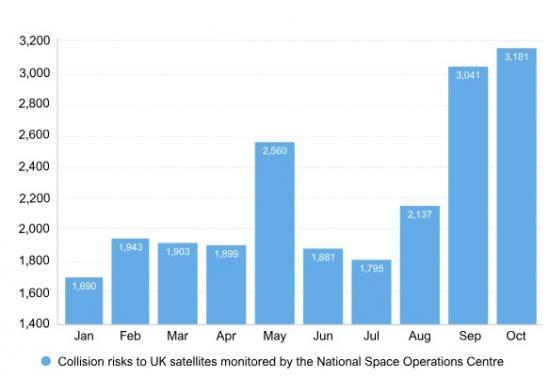How We Protected The Uk And Space In October 2024
19th November 2024

This report was issued in November 2024 and covers the time period 1 October 2024 to 31 October 2024 inclusive.
October saw a slight increase in collision alerts from September. Fewer large objects re-entered the Earth's atmosphere in October compared to September and we expect this trend to continue as planned re-entry campaigns dwindle. All NSpOC warning and protection services functioned as expected throughout the period.
Uncontrolled Re-Entry Early Warning
This month has seen a further reduction in the number of objects re-entering Earth's atmosphere compared to the previous two months, mainly due to a reduction of planned re-entry campaigns.
Of the 35 large objects monitored for re-entry this month, 17 were communications satellites, seven were payloads and the rest of the objects were debris or rocket bodies. Of note, three payloads were from launches in the early to mid-1980s.
Chart showing number of re-entries monitored by month. January: 13, February: 24, March: 25, April: 22, May: 56, June: 48, July: 44, August: 89, September: 50, October: 35.
In-Space Collision Avoidance
Collision risks to UK licenced satellites have steadied with only a slight 4.6% increase during October. This is in line with the prediction that the monthly average will remain higher than previous months.
Fragmentation analysis
NSpOC has been monitoring the Intelsat-33E GEO communications satellite break-up. The current commercial SDA provider tally of fragments ranges from 100-500 pieces of debris. Objects are still being analysed but we expect the catalogued debris count to be in this range.
Space weather
Space weather activity was more impactful in October than in September, with the Met Office sending more alerts this month.
The month started out with some Minor to Strong radio blackouts, leading into a more active second week where four X-class solar flares were observed.
A Coronal Mass Ejection (or CME - a burst of magnetised plasma emitted from the Sun) arrival late on the 6th formed a Strong geomagnetic storm.
A significant CME arrival gave Severe geomagnetic storming on the 10th and 11th, which resulted in the aurora being visible at lower latitudes than normal. This CME was released during one of the solar flares, also causing a Strong radiation storm, which gradually eased on the 11th.
We had a calmer mid-month, although frequent Minor flaring and Minor radio blackouts continued. Activity increased to end the month with X-class solar flares on the 24th, 26th and 31st.
A CME arrival on the 28th gave a Minor geomagnetic storm. Proton flux increased due to one of the solar flares, which caused a Moderate radiation storm over the 27-29th period, easing on the 31st.
Number of Objects in Space
There was an overall reduction to the in-orbit population during October, with just 203 newly catalogued objects being added to the US Satellite Catalogue and more objects de-orbiting.
Some of these new objects were from launches at the end of September, 106 are Starlink satellites, and 51 were additional debris pieces catalogued from the LM-6A (CZ-6A) fragmentation which occurred at the beginning of August.
Chart showing number registered space objects by month. January: 28,014, February: 28,172, March: 28,478, April: 28,752, May: 28,850, June: 28,931, July: 28,917, August: 29,297, September: 29,678, October: 29,665.
Comments
The National Space Operations Centre combines and coordinates UK civil and military space domain awareness capabilities to enable operations, promote prosperity and protect UK interests in space and on Earth from space-related threats, risks and hazards.
See chars at https://www.gov.uk/government/news/how-we-protected-the-uk-and-space-in-october-2024
